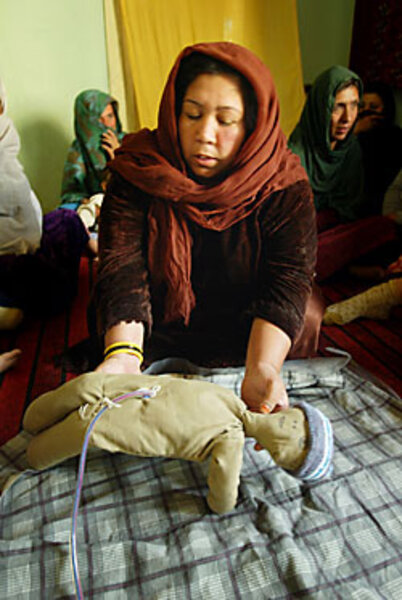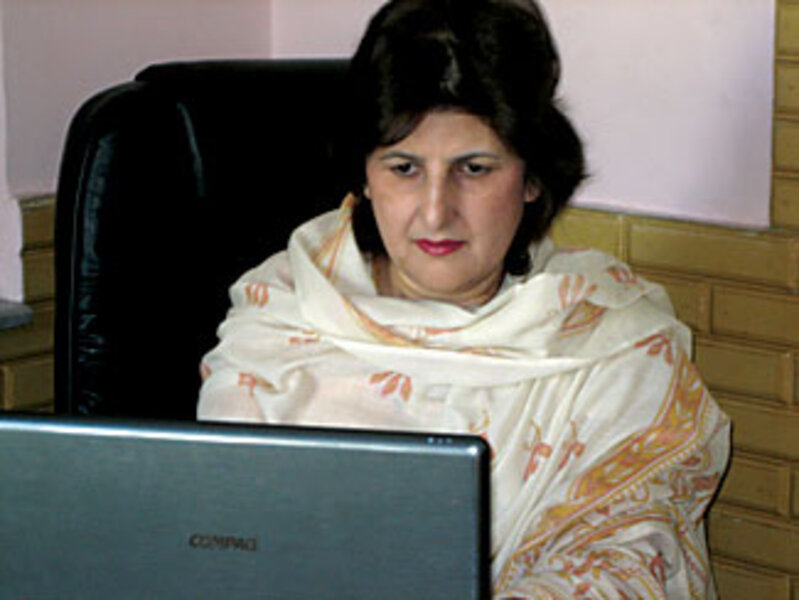Amid war Afghanistan trains thousands of new midwives
Loading...
| Kabul, Afghanistan
Through a courtyard piled high with heaps of trash and teeming with flies, two sturdy women sit in a cool, dark room before a group of nearly a dozen women who range in age from 15 to 50. The two are midwives who have come to talk to the women living here with limited electricity and little clean water about the importance of maternal health.
Girls from nearby houses stream in as the midwives begin their presentation, pouring water from a clay-colored pitcher and moving their soapy hands slowly clockwise to show the proper method of hand washing.
When an older woman tells a girl living next door she is too young to join the session, the midwives intervene. The more learning, the better, they say, in a country plagued by the world's second-highest maternal mortality rate.
Afghanistan's capacity to address the health of its women has taken a remarkable turn for the better in the past seven years. In 2002, 60 percent of Afghans had no access to basic health services, according to a study led by Linda Bartlett, then of the Centers for Disease Control and Prevention in Atlanta. Furthermore, two-thirds of the country's districts had neither maternal nor child health services, with only 10 percent of Afghanistan's hospitals equipped for caesarean deliveries. Nearly 80 percent of the maternal deaths examined in Dr. Bartlett's study were judged preventable.
But today, maternal health is among the nation's most tangible signs of progress thanks to projects such as this one sponsored by Terre des Hommes (TDH); investment by the international community in a network of clinics; and the growth of midwifery training programs. Afghanistan now finds itself in the rare position of serving as a role model for other poor countries seeking to quickly improve their ability to save women's lives.
Pashtoon Azfar, head of the Afghan Midwives Association, says the number of trained midwives has grown nearly six-fold since rebuilding effort in Afghanistan began. "In 2002, we had 467 midwives, but no one knew how qualified they were; for years, they had received no access to training," says Ms. Azfar, also a midwifery specialist with the international nonprofit health organization Jhpiego, whose maternal health programs are funded by the US Agency for International Development (USAID). Today, there are more than 2,400 midwives around the country who have been trained in a standardized and accredited two-year program, she says.
"There are very good lessons to be learned from Afghanistan," says Bartlett. "The midwifery education program appears to be a real success story that could inform programs in other countries."
Certainly much remains to be done in a country where poverty and illiteracy run rampant and infrastructure in the most remote regions is still meager. Afghanistan's Ministry of Public Health is now launching a follow-up survey to assess the impact of recent maternal health efforts, seven years after the last round of research began.
Midwives see progress
Midwives working in the field say that they see signs of improvement every day in the communities they visit. This is thanks in large part to the growing role of skilled birth attendants whose services are now accessible to many women throughout the country, including those in hard-to-reach rural regions, where midwife use jumped from 6 percent in 2003 to 19 percent three years later, according to Johns Hopkins University research.
Dr. Noorkhanoom (some Afghans use only one name), has been making house calls to Kabul's poorest families since 1996, when she went to work for TDH. She joined TDH, a Swiss nongovernmental organization, after being barred by the Taliban from her university job teaching medicine.
During this home visit, Noorkhanoom shakes her head when a woman in the group says that her husband is beating her. The men of her own family are coming to talk to her husband today, the woman tells the doctor, looking down at the worn trousers of her mint-green pants suit.
The doctor turns to the woman's mother-in-law and asks her what can be done. The mother-in-law shrugs and confesses she is unable to meddle in her son's affairs.
The group is silent for a moment before the midwives resume their presentation, using a young woman in the group who is 17 and pregnant with her first child to demonstrate how to keep the delivering mother comfortable during labor. They show how to support the baby's neck when it emerges and how to cut the umbilical cord. The women seated before them listen rapt with attention, asking questions throughout. When the visit is finished an hour later, each of the ladies rises to hug the midwives and the doctor.
The visits are part of TDH's Maternal and Child Health Home Visiting Program. Six days a week, from early morning to dusk in Kabul and Kandahar, TDH's 50 midwives, working in teams of two, knock on doors and follow up on referrals, bringing their presentations to as many women as they can gather together. The program counts 110,000 beneficiaries in the capital alone.
Azfar, of the Afghan Midwives Association, says the increase in the number of trained midwives is not only a lifeline for mothers – it's an economic boon for the midwives.
"If people think a midwife in their family will be contributing to the household, fathers and brothers will support their mothers and wives and daughters," says Azfar. "If a woman has any economic role in the family, for sure she has some decisionmaking role as well. That is why I am an advocate of this. It is not just for midwifery – it is for change."
Both Azfar and Noorkhanoom say the best way to cement such gains is to improve security. "You cannot expect so much change in one or two or even five years," says Noorkhanoom. "I hope the international community will continue to support us; they left us once, and they saw the negative results.... If they leave this country again, it will be a crime."






